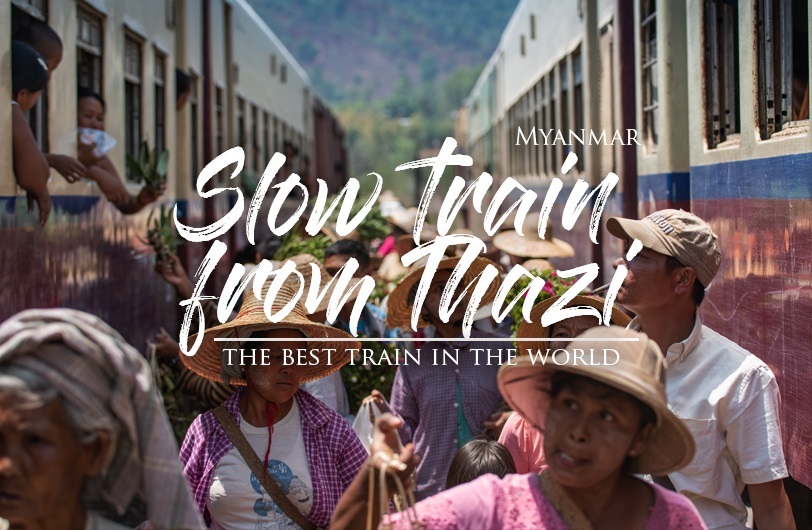SLOW TRAIN FROM THAZI – the best train in the world
A gentle tug makes me aware that the train has started. I slowly leave the Thazi station behind me and watch the landscape behind glassless windows move at a speed of less than 30 km / h. The wooden bench I sit on is not the most comfortable and I start to wonder if choosing a lower class was the best decision. After all, I will spend the next 11 hours here.
– Hello! Sir! – a voice reaches me from a distance. Finally a hand taps my shoulder. – Sir, Thazi!
I wake up immediately. I am shocked that I was able to fall asleep at all. Admittedly, I have the extremely useful ability to sleep anywhere, but I was convinced that the place I occupied did not meet the criteria of “anywhere.” You can write almost anything about the “OK Bus” minibus, except that it is OK. Me and a group of unfortunates did our very best to squeeze in the seats designed for passengers of -10 age group, in positions not causing a loss of blood circulation in the limbs.
01:00 am has struck and after 5 hours of torture, I am alone somewhere in central Burma, in the town of Thazi, known only for the fact that two railway lines meet here. Seriously – most of your searches for information about it will end on a page with a name and a blank page. There are probably 2 “hotels” here, and that’s about it. I check my location on maps.me and head towards the station. The empty street is illuminated by irregularly placed dying lamps. There is not a single living soul around, except for a few stray dogs napping. These creatures, in different circumstances and places in Burma, being the most relaxed animals next to sloths, suddenly begin to show dislike for me. Being furiously barked at, I keep walking with the heart in my throat until I reach the station building. My companions finally disappear in the darkness.
The Thazi station is not big. Just two ticket counters, a few benches and people sleeping on mats spread out on the ground. I find a seat on one of the benches, realizing that I will spend the rest of the night here. I barely sit down when the lights all over the neighborhood go out. In the darkness on the adjoining bench I can only hear the sound of crunching rice wafers. The restaurant owner across the square lights the candles. Power cuts are a daily occurrence in Myanmar and most hotels have their own power generators as a backup. This time the break lasts over an hour.
Before dawn, the station comes alive twice when trains from Yangon to Mandalay enter the platform. Finally, before 6:00 am I decide to buy my ticket. I am invited to the manager’s room, where I pay less than a 1USD and receive a handwritten ticket.


The monk taking my place does not believe that the ticket is for “ordinary” class and directs me to the next car. There, the controller decides that the monk is wrong and after a moment of confusion, I finally take my place on a wooden bench in front of an elderly gentleman. He takes a medium-sized leaf from his bag, spreads it with a white paste, sprinkles some mysterious herbs over it from several different containers, then wraps it all up and puts it in his mouth. It is betel, the most popular stimulant in Burma. It can be purchased for pennies practically everywhere. You will recognize people using it by their bloody red teeth.
The interior of the wagon is unique. Through the cracks in the floor planks I can see the moving substrate. Nearby, three women are lying on large packages, and right behind my bench there are decent sized bags with letters and postal items. The landscape behind windowless frames moves lazily at a speed of less than 30 km / h. However, you have to watch out for bloodthirsty bushes, bursting inside from time to time with evil intentions towards the faces of inattentive passengers. Despite the low speed, the wagon rocks like a boat in a storm. On faster lines, where train speeds reach a dizzying 50 km / h, it is said to be even more noticeable. It is not surprising since the tracks were built by the British back in colonial times.
The train on the Thazi – Shwenyaung line is called “slow” for a reason. The distance of 247 km is covered in 11 hours. On the way, the train stops at numerous stations where the arrival of the train is the highlight of the day. Women with baskets on their heads appear on the platform, selling their goods. Each station seems to have a theme. For one it is vegetables, for another flowers. Trade mostly takes place through the windows, but sometimes passengers go out to the platform to buy something at the provisional stands.
We are slowly climbing the green hills. The train changes the direction several times to be able to zigzag up to the right altitude. The landscape outside the window changes beyond recognition. From sun-scorched plains, through green hills, to highlands marked with arable fields. The attitude of my fellow passengers also changed a bit. At first a bit embarrassed, they begin to show more interest in a foreigner smacking himself on a wooden bench. I also make a connection with my neighbor. I end up showing photos of my family and a short movie about Poland that I always have on my tablet. When the man has to get off at his station, he says goodbye to me like an old friend and waves from the platform until the train gets out of his sight. Yet he didn’t speak a word in English.
When I finally reach Shwenyaung after nearly 11 hours I no longer feel like a tourist thrown into the middle of local life. All nearby passengers say goodbye to me. The train ice cream vendor smiles goodbye, the ticket inspector waves me from a distance, and I become certain that people are Myanmar’s greatest treasure.
PRACTICAL INFO
– Check out the website: https://www.seat61.com/Burma.htm It is a real treasury of knowledge about Burmese trains.
– You can buy the ticket at the station. A seat in the regular class costs 1300KYAT, in the higher class it is a bit more expensive. The seats in the upper class are definitely more comfortable, but on wooden benches you will experience more local atmosphere.
– Stock up on something to eat. While drinks can somehow be refilled at the stations, a closer contact with the food sold there may end in different ways.
– There are two places where you can sleep in Thazi: Moonlight guesthouse and Wonderful guesthouse.
– At the Thazi station, the toilet is at the end of the platform in a barrack you would never suspect of its purpose. Once you go inside, this feeling will not change. Using the toilet can be an adventure.











